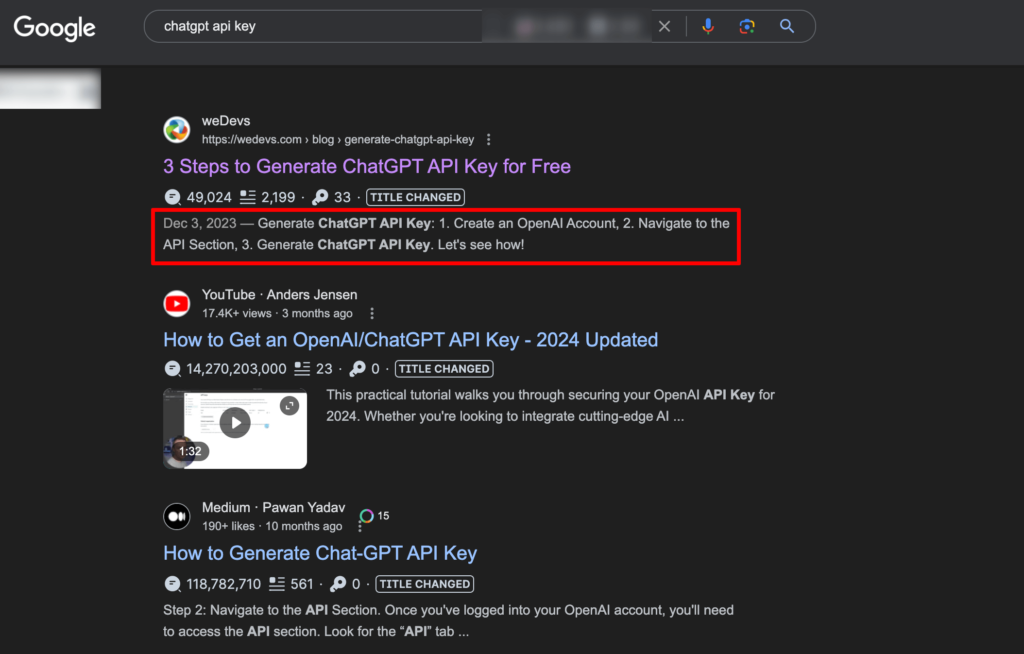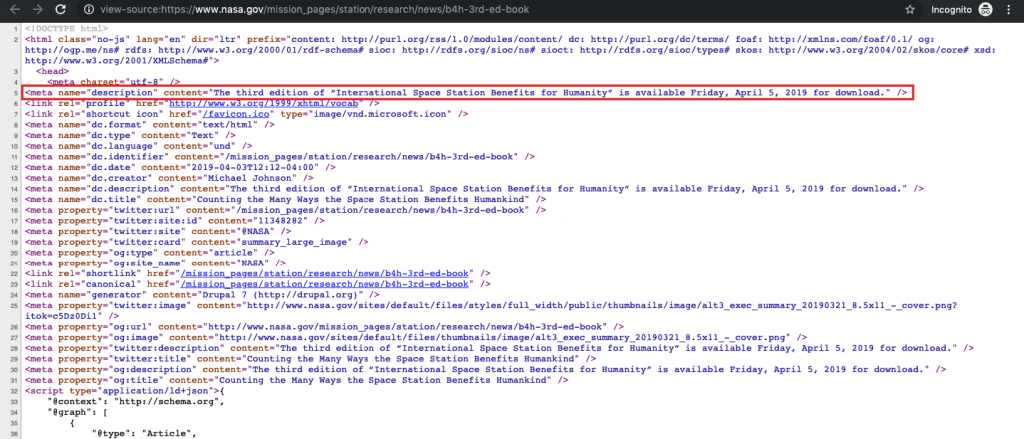
What is Meta Description – Tips, Tools, Examples, and Templates for Beginners
Writing perfect meta descriptions can be equally easy and complicated for you. It can be tough if you don't know how to write a meta description properly. In the same way, it can be super easy if you follow the right tips to optimize it.
Though Meta Description is an old-school theory for SEO, it still works great to thrust your web page to the top.
If you are wondering how to write meta descriptions that boost your SEO, no worries. In this comprehensive guide, we will share everything about meta descriptions. So, let's get started!
What is Meta Description?
In non-technical terms, the meta description is nothing but a short snippet of texts that tell the search engines and the searchers what your web page is all about.
Typically, it is a concise paragraph of 155-160 characters. Search engines often display the meta description in search results, below the page title, which helps users understand the page's content before clicking on the link.

A well-crafted meta description can improve click-through rates from search engine results pages (SERPs) by making the webpage more appealing to potential visitors.
How Meta Description Works
The meta description is pulled from the meta description attribute. However, if the meta description is not specified, then Search Engines can fetch this text from the main body of the webpage.
Here is how a meta description works:
- Search Engine Crawling: When search engine bots crawl a webpage, they read the HTML code, including the meta description tag. This helps the search engine understand the content of the page.
- Indexing: The information in the meta description can be used by search engines to index the page appropriately. While meta descriptions are not a direct ranking factor, they contribute to the relevance of the page in search results.
- Display in SERPs: When a user performs a search query, the search engine displays a list of results, often showing the meta description under the page title and URL. This snippet provides context to the user about what they can expect from the webpage.
Meta descriptions serve as a bridge between search engine algorithms and user intent, helping to drive relevant traffic to webpages.
Why Meta Description is Important
Meta description improves your CTR rate. It also helps your reader to understand what this page is about, which enhances the user experience. Let's check more about it:
- Higher Click-Through Rates (CTR): Imagine your meta description as a tiny billboard ad for your webpage in search results. A well-written description that entices users with relevant keywords and a clear explanation of your content will get more clicks compared to vague or poorly written descriptions. This translates to more visitors to your site from search engines.
- Improved User Experience: Meta descriptions help users decide if your webpage is relevant to their search. A clear and informative description sets expectations and avoids frustrating users who click through only to find something completely different. This can improve user experience and potentially lead to repeat visits.
If you are not convinced yet, here is another fact taken from Moz.
Putting it all together, we're up to almost 55% of cases where Google is using all or part of the original meta description tag.
Moz
So, it is quite obvious how significant the meta description is for your web pages.
How to Write Better Meta Descriptions – 8 Proven Tips for Beginners

As we said earlier, writing meta description can be easy if you follow the correct ways to optimize it. In this segment, we will show you how to write better meta descriptions for your web pages. Let's check it out!
01. Keep It Concise
Meta descriptions should be concise, ideally between 150-160 characters. This ensures they are fully displayed in search engine results, making it easier for users to quickly understand the page content without being cut off.
Example:
- Bad: “Explore our extensive range of high-quality, organic, natural skincare products designed to cater to all skin types and conditions. Enjoy free shipping on orders over $50, along with a satisfaction guarantee.”
- Good: “Explore our range of organic skincare products. Free shipping on orders over $50!”
02. Include Target Keywords
Integrate relevant keywords naturally to match user search queries. However, in terms of adding the main keyword to your meta description, don't do it forcefully. If your main target keyword doesn't go with the meta description naturally, try related keywords.
Example:
- Bad: “Find the best shoes. Great deals and discounts on all items.”
- Good: “Buy affordable men’s running shoes. Top brands available with free returns.”
Here, “affordable men's running shoes” is the target keyword.
03. Be Clear and Relevant
The meta description should accurately reflect the content on the page. Misleading descriptions can lead to high bounce rates as users leave the page when they don't find what they expected.
Example:
- Bad: “Discover amazing recipes and tips. Click here for more information.”
- Good: “Learn how to cook a perfect steak with our step-by-step guide and video tutorial.”
04. Use Actionable Language
Use verbs and action-oriented language to encourage users to take specific actions. This makes the description more engaging and prompts users to click through to the page.
Example:
- Bad: “Newsletter available for subscription. Discount on first purchase.”
- Good: “Sign up for our newsletter and get 10% off your first purchase.”
05. Highlight Unique Selling Points
Emphasize what sets your page or product apart from others. Highlight unique features, benefits, or offers that make your content or product special.
Example:
- Bad: “Buy our bikes. Good quality and many features.”
- Good: “Shop our award-winning electric bikes. Long battery life and free shipping!”
06. Create a Sense of Urgency
When appropriate, create a sense of urgency to prompt immediate action. This can be done by mentioning limited-time offers, exclusive deals, or other time-sensitive elements.
Example:
- Bad: “Check out our summer clothing. Discount available.”
- Good: “Limited time offer! Save 20% on all summer clothing.”
07. Ensure Readability
Write in complete sentences and avoid keyword stuffing. The description should read naturally and professionally, ensuring it is easy to understand and engaging for users.
Example:
- Bad: “Vegan recipes delicious and easy to make for beginners vegan food.”
- Good: “Discover delicious vegan recipes that are easy to make. Perfect for beginners!”
08. Incorporate a Call to Action (CTA)
Encourage users to take a specific action with clear calls to action. This directs users towards the next step, whether it's downloading a resource, signing up, or making a purchase.
Example:
- Bad: “Learn the secrets of digital marketing. Free eBook available.”
- Good: “Download our free eBook now to learn the secrets of digital marketing!”
Follow these tips to create effective meta descriptions that not only attract clicks but also improve the overall user experience and page performance in search engine results.
To get more help with SEO, CTA, and CTR, you can check out these additional resources:
- Common SEO Tactics You Should Stay away from to Ensure the Best Result.
- 10 WordPress SEO Mistakes to Steer Clear of.
- Increase the Click through Rate with These Call to Actions in Writing.
4 Meta Description Templates to Use Instantly
To save you time, here are meta description templates that may help you craft amazing meta descriptions for your web pages.
Tutorial Blogs:
Doing "Focus Keyword" is very important. Ever wondered how to do it? Here is our comprehensive and effective guide to do it which can give you a boost.Landing Pages:
Do you find it difficult to do "Keyword"? Then you can try "Your solution" that can lessen your pain and make you more efficient like never before. Pricing Pages:
Compare "Your product" with other solution providers with an amazing chart and make your decision to buy the "product" wisely exactly the way others did.Documentation Pages:
This documentation explains the "Keyword" feature of "Your product". If you want to learn how it works you can go through this documentation.Top Meta Description Tools for You in 2026

There are several tools available that can help you create, analyze, and optimize meta descriptions. These tools are designed to ensure your meta descriptions are effective, compliant with search engine requirements, and engaging for users.
Here are some of the top meta description tools:
I) Yoast SEO
Yoast SEO is a popular WordPress plugin that provides real-time analysis of your content, including meta descriptions. It offers suggestions to improve SEO and readability.
Key Features:
- Real-time analysis and suggestions
- Snippet preview for mobile and desktop
- Keyword optimization
Example Use: While writing a blog post, Yoast SEO provides feedback on the meta description length and keyword usage, ensuring it is optimized for search engines.
II) SEMrush
SEMrush is an all-in-one marketing toolkit that includes tools for SEO, PPC, content marketing, and more. It offers features to analyze and optimize meta descriptions.
Key Features:
- On-page SEO checker
- Competitor analysis
- SEO content template
Example Use: Use the On-Page SEO Checker to review meta descriptions and receive optimization suggestions based on top-ranking competitors.
III) Ahrefs
Ahrefs is a comprehensive SEO toolset known for its backlink and keyword analysis. It also includes features to optimize meta descriptions.
Key Features:
- Site audit tool
- Content analysis
- SERP analysis
Example Use: Conduct a site audit to identify pages with missing or underperforming meta descriptions and get recommendations for improvement.
IV) Screaming Frog SEO Spider
Screaming Frog SEO Spider is a website crawler that helps identify SEO issues, including meta descriptions.
Key Features:
- Site crawling
- Meta description length checker
- Duplicate content detection
Example Use: Crawl your website to find pages with missing, duplicate, or overly long meta descriptions and make necessary adjustments.
V) Moz Pro
Moz Pro is an SEO toolset that offers various features for keyword research, link building, and on-page optimization, including meta descriptions.
Key Features:
- Page optimization
- Keyword explorer
- Rank tracking
Example Use: Use the Page Optimization tool to get detailed insights on improving meta descriptions for better search engine visibility.
VI) Rank Math
Rank Math is another WordPress SEO plugin that simplifies the optimization process for meta descriptions and other SEO elements.
Key Features:
- Real-time content analysis
- Snippet preview
- Focus keyword optimization
Example Use: Get real-time suggestions for meta descriptions while creating content in WordPress, ensuring they are optimized for search engines.
Bonus: How to Check a Web Page's Meta Description?
It's pretty easy! Go to the page of a web page then, right-click your mouse after that select the View Page Source option from the box.

Moving forward, you will probably be able to see the meta description within a bunch of codes. Here is an example of a meta description on the “View Page Source”:

Here is the above Meta description in texts:
<meta name="description" content="The third edition of “International Space Station Benefits for Humanity” is available Friday, April 5, 2019 for download." />Most Common FAQs on Meta Descriptions
Not directly. Google treats meta descriptions as storytellers, not scorekeepers. They don’t boost rankings on their own, but a clear, magnetic description can increase click-through rate, which indirectly nudges your SEO performance upward.
Google will craft its own snippet from your page, often grabbing whatever text it finds first. Sometimes it’s helpful, other times it reads like a sentence caught mid-yawn. Writing your own gives you control over how your page greets searchers.
Yes. Each page deserves a distinct little invitation. Unique meta descriptions help users understand what’s behind each link and prevent search engines from treating your pages like near-duplicates.
Aim for about 150–160 characters. Long enough to deliver value, short enough to avoid being trimmed into ellipses. Think of it as a miniature billboard for your content.
SEO Meta Description – Key Takeaways
Meta descriptions are crucial for attracting users to your webpage in search results, even though they don't directly affect search ranking.
Here's a recap of the key points to remember:
- Concise and Clear: Aim for around 155 characters to ensure your description appears fully displayed in search results.
- Benefit-Driven: Focus on the value users get from your webpage. What problem do you solve? What information do you provide?
- Keyword Magic: Include relevant keywords users might search for, but prioritize readability over keyword stuffing.
- Active Voice Wins: Use strong verbs and clear language to make your description easy to understand.
- Compelling Call to Action: Tell users what you want them to do after reading your description (e.g., “Learn More,” “Shop Now”).
- Uniqueness Matters: Don't use generic descriptions. Write unique meta descriptions for each webpage that accurately reflects its content.
- Emotional Connection (Optional): When appropriate, consider using emotional language to pique user interest or create excitement.
- Test and Refine: Track your click-through rates (CTR) and experiment with different descriptions to see what resonates best with your target audience.
That's all from our end.
Now it's your turn. If you have any queries related to this article, feel free to share them with us using the comment box below. We would love to know your feedback.